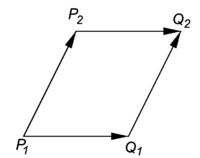Affine space: Difference between revisions
imported>Paul Wormer |
imported>Paul Wormer |
||
| Line 49: | Line 49: | ||
+ \overrightarrow{P_1Q_1} = \vec{0}. | + \overrightarrow{P_1Q_1} = \vec{0}. | ||
</math> | </math> | ||
==Position vector== | |||
Choose a fixed point ''O'' in the affine space ''A''. Every point ''P'' is uniquely determined by the vector <math> \vec{v} \equiv \overrightarrow{OP} \in V</math> (by the second requirement). | |||
The vector <math>\vec{v}</math> is the ''position vector'' of ''P'' with respect to ''O''. After choosing ''O'' every point ''P'' can be uniquely identified with its corresponding position vector in ''V''. Choice of another point ''O''′ gives a translation of <math>\vec{v}</math> by <math>\vec{t} \equiv \overrightarrow{OO'}</math>, for | |||
:<math> | |||
\vec{v} \equiv \overrightarrow{OP} = \overrightarrow{OO'}+ \overrightarrow{O'P} = \vec{t} + \vec{v}\;' | |||
</math> | |||
with <math> \vec{v}\;' \equiv \overrightarrow{O'P}</math>, the position vector of ''P'' with respect to ''O''′. | |||
Revision as of 10:48, 6 November 2008
The 2- and 3-dimensional point spaces studied in elementary Euclidean geometry are examples of affine spaces, A2 and A3, respectively.
Assume that any two points P and Q in a space A can be connected by a line segment in A; this possibility is Axiom 1 of Euclidean geometry. If we order P and Q (we say that P comes before Q), then the line segment obtains a direction (points from P to Q) and has become a vector, the difference vector . When all difference vectors can be mapped onto vectors of the same n-dimensional vector space Vn, we may call the point space A an affine space of dimension n, written An.
Usually one takes as a difference space an inner product space. Its elements have a well-defined length, namely, the square root of the inner product of the vector with itself. The distance between points P and Q in an affine space is then defined as the length of the image of in Vn. Difference vectors that are mapped onto the same element of Vn are said to be parallel, they differ from each other by translation.
Formal definition
We will restrict the definition to vector spaces over the field of real numbers. Let V be an n-dimensional vector space and A a set of elements that we will call points. Assume that a relation between points and vectors is defined in the following way:
- To every ordered pair P, Q of A there is assigned a vector of V, called the difference vector, denoted by .
- To every point P of A and every vector of V there exists exactly one point Q in A, such that
- If P, Q, and R are three arbitrary points in A, then
If these three requirements are fulfilled, the set A is called an n-dimensional affine space with the difference space V.
Immediate consequences:
Parallelogram law
Consider four points in A: P1, P2, Q1, and Q2. Assume that the following difference vectors are equal, i.e., the corresponding line-segments in A are parallel and of equal length:
then the four points form a parallelogram, that is,
see the figure.
Proof Subtract the following equations:
This gives
Position vector
Choose a fixed point O in the affine space A. Every point P is uniquely determined by the vector (by the second requirement). The vector is the position vector of P with respect to O. After choosing O every point P can be uniquely identified with its corresponding position vector in V. Choice of another point O′ gives a translation of by , for
with , the position vector of P with respect to O′.
















